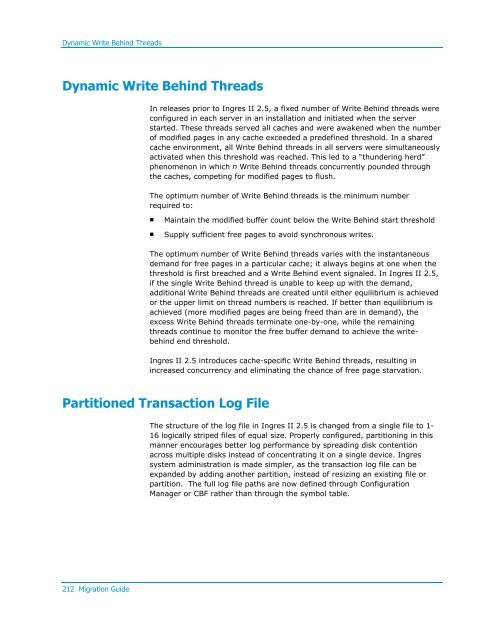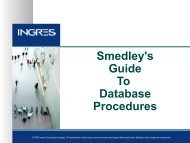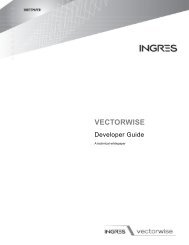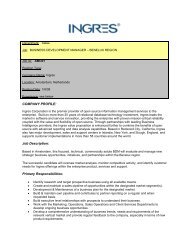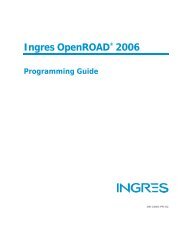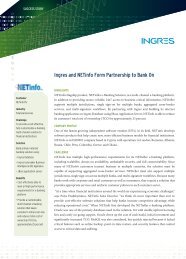Ingres 9.2 Migration Guide - Actian
Ingres 9.2 Migration Guide - Actian
Ingres 9.2 Migration Guide - Actian
You also want an ePaper? Increase the reach of your titles
YUMPU automatically turns print PDFs into web optimized ePapers that Google loves.
Dynamic Write Behind ThreadsDynamic Write Behind Threads In releases prior to <strong>Ingres</strong> II 2.5, a fixed number of Write Behind threads wereconfigured in each server in an installation and initiated when the serverstarted. These threads served all caches and were awakened when the numberof modified pages in any cache exceeded a predefined threshold. In a sharedcache environment, all Write Behind threads in all servers were simultaneouslyactivated when this threshold was reached. This led to a “thundering herd”phenomenon in which n Write Behind threads concurrently pounded throughthe caches, competing for modified pages to flush.The optimum number of Write Behind threads is the minimum numberrequired to:• Maintain the modified buffer count below the Write Behind start threshold• Supply sufficient free pages to avoid synchronous writes.The optimum number of Write Behind threads varies with the instantaneousdemand for free pages in a particular cache; it always begins at one when thethreshold is first breached and a Write Behind event signaled. In <strong>Ingres</strong> II 2.5,if the single Write Behind thread is unable to keep up with the demand,additional Write Behind threads are created until either equilibrium is achievedor the upper limit on thread numbers is reached. If better than equilibrium isachieved (more modified pages are being freed than are in demand), theexcess Write Behind threads terminate one-by-one, while the remainingthreads continue to monitor the free buffer demand to achieve the writebehindend threshold.<strong>Ingres</strong> II 2.5 introduces cache-specific Write Behind threads, resulting inincreased concurrency and eliminating the chance of free page starvation.Partitioned Transaction Log FileThe structure of the log file in <strong>Ingres</strong> II 2.5 is changed from a single file to 116 logically striped files of equal size. Properly configured, partitioning in thismanner encourages better log performance by spreading disk contentionacross multiple disks instead of concentrating it on a single device. <strong>Ingres</strong>system administration is made simpler, as the transaction log file can beexpanded by adding another partition, instead of resizing an existing file orpartition. The full log file paths are now defined through ConfigurationManager or CBF rather than through the symbol table.212 <strong>Migration</strong> <strong>Guide</strong>


